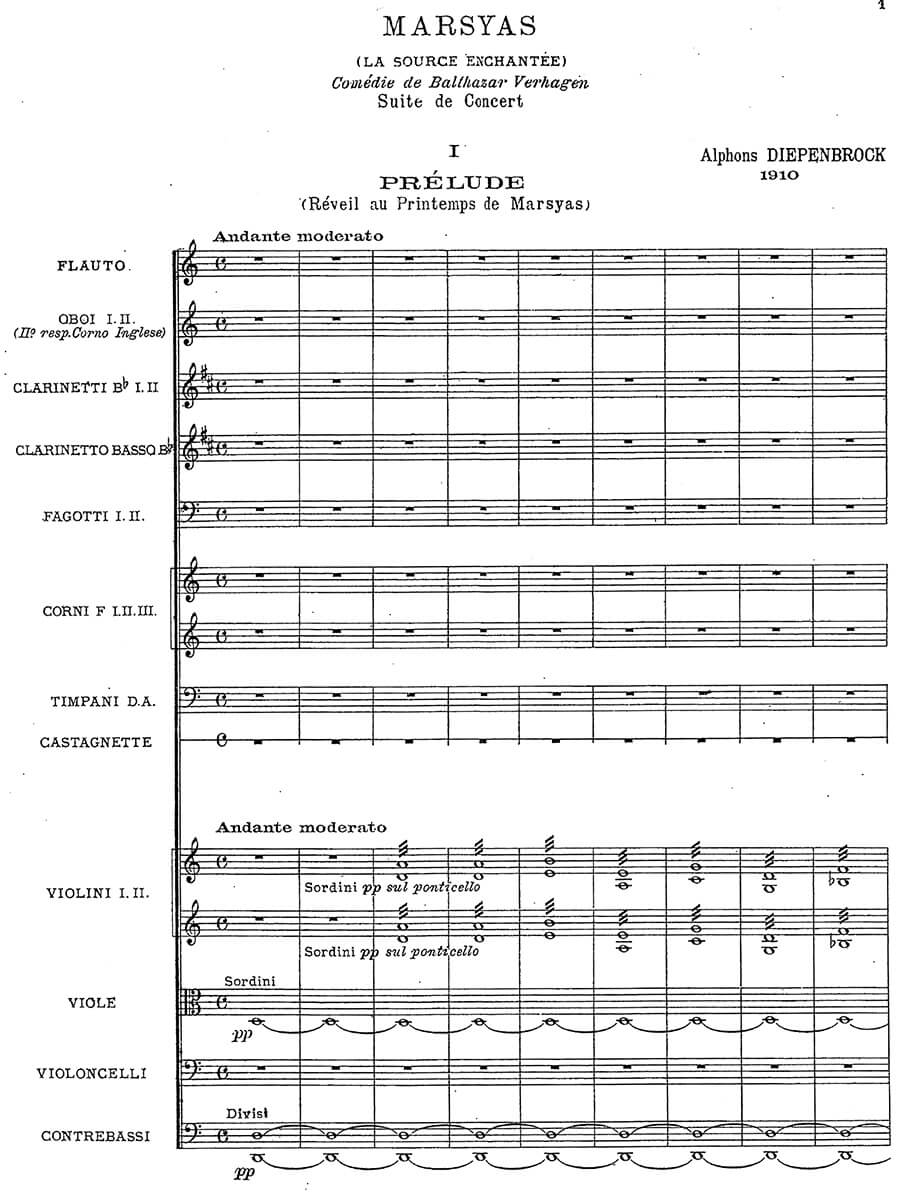Marsyas, suite for orchestra
Diepenbrock, Alphons
36,00 €
Preface
Alphons Diepenbrock – Marsyas (1910/1911)
(b. Amsterdam, 2. September 1862 – d. Amsterdam, 5. April 1921)
Preface
For a long time the bon mot of the Netherlands as the country without music was valid. Gone are the days of the famous masters of vocal polyphony of the 16th century, such as Jan Pieterszoon Sweelinck. This only changed at the end of the 19th century, with the opening of the Concertgebouw Amsterdam and the founding of the world-famous Concertgebouw Orkest Amsterdam, both in 1888. Alphons Diepenbrock was the first Dutch composer to enjoy international fame after a long time, although he had never received any musical training! Born in 1862 into a wealthy family, he already showed musical talent as a child. He learned to play the violin, the organ and the piano. Nevertheless, music was not to play a central role in his life at first. He studied classical philology in Amsterdam from 1880 and completed his doctorate on Seneca in 1888. He left Amsterdam to take up a post as a high school teacher in ‘s-Hertogenbosch in the same year. However, the teaching profession did not fulfil him. In 1891 he completed his first major composition, the Missa in die festo. In 1895 he finally returned to Amsterdam. He only taught the old languages privately and devoted himself more to composing. For a long time he had been composing in his spare time without ever having been taught; he acquired his musical knowledge through numerous books on music theory. In addition, he attended concerts at the Concertgebouw whenever his time allowed. He even moved into a flat near the Concertgebouw in order to get there as easily as possible. The conductor of the Concertgebouw Orkest, Willem Mengelberg, gave him the opportunity to perform his own works with this outstanding orchestra. Diepenbrock experienced his breakthrough as a composer in 1900, with the performance of his Hymns to the Night.
In addition to the ancient languages and composing, Diepenbrock also published numerous writings on other subjects, such as philosophy and religion. His writings were held in higher esteem than his musical works at this time. His strong interest in literature led him to write predominantly text-bound music, i.e. mainly vocal music. In his works, he combined more recent influences, such as the chromatically enriched music of Wagner, later also Mahler (with whom he was also friends) and Debussy, as well as with the polyphony of the Flemish masters of the 16th century.
Due to his love of the ancient languages, it is only natural that Diepenbrock also found suitable models for his music in the Greek mythology. The theatre music for “Marsyas, oder Die verzauberte Quelle” (Marsyas, or The Enchanted Spring) by Balthazar Verhagen, a former pupil of Diepenbrock, was written in 1909-1910 and is based on a Greek myth handed down by Xenophon. In it, the goddess Athena invented the flute. She stopped playing the flute, however, because she thought it would distort her face. The faun Marsyas found the discarded flute and played the instrument with great perfection. A musical contest ensued with the lyre-playing god Apollo. Apollo won and had Marsyas drowned. The river Marsyas was formed from the tears. The first performance of Marsyas in the Amsterdam Palace of Industry of N.V. Het Tooneel took place on 4 October 1910. Eleven further performances with Diepenbrock’s music followed: six repetitions in Amsterdam and others in Rotterdam, Arnhem, Leiden, The Hague and Haarlem. The fact that almost all critics were of the opinion that ultimately the music was the most valuable element of Marsyas encouraged Diepenbrock to realize a concert performance by the Concertgebouw Orchestra. As early as February 1911, the composer conducted the orchestra twice with parts of the incidental music, thus laying the foundation for the orchestral suite, which has been performed regularly ever since and was published in 1927.
The orchestral instrumentation is relatively small. Diepenbrock had only 30 musicians at his disposal. He calls for only one flute (also piccolo), two oboes (also cor-anglais), two clarinets, bass clarinet, two bassoons, three horns, harp, timpani, percussion (to be played by one person) and strings. This manageable instrumentation is typical for stage music of this period; the instrumentation in Sibelius’ stage music, for example, is similarly small. Of course, the flute and harp play an important instrumental role, in keeping with the plot of the stage play. The suite begins with the prelude to Act 1, depicting Marsya’s spring awakening. The second movement was the entr’acte music that connected Act 1 with Act 2. In it Diepenbrock depicts the wandering of the faun in the forest. In the third movement, “Marsyas and the Nymphs”, the nymphs of the river mock Marsyas, who has lost the contest. The fourth movement is identical to the prelude to Act 3 and transports the listener to a balmy summer night. The concluding fifth movement is the music for a passionate dance of the nymphs and Apollo’s epilogue.
Playing time: approx. 35 minutes
Marcus Prieser 2021
For performance material please contact Donemus, Amsterdam.
Score Data
| Edition | Repertoire Explorer |
|---|---|
| Genre | Orchestra |
| Size | 210 x 297 mm |
| Printing | Reprint |
| Pages | 160 |
